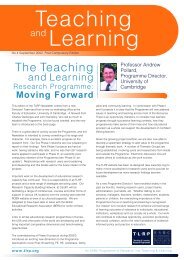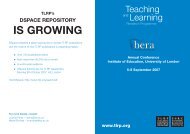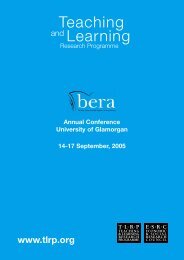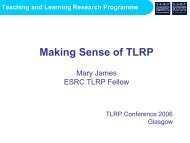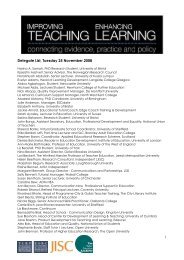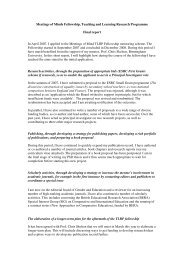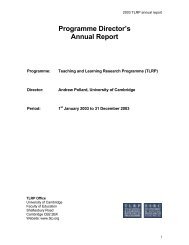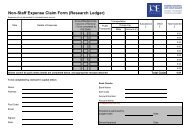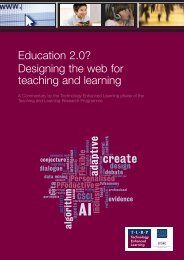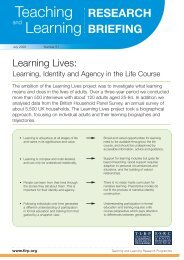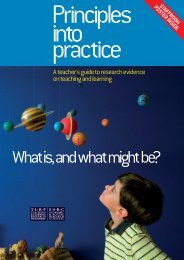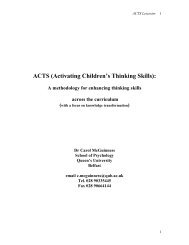Assessment in schools Fit for purpose? - Teaching and Learning ...
Assessment in schools Fit for purpose? - Teaching and Learning ...
Assessment in schools Fit for purpose? - Teaching and Learning ...
Create successful ePaper yourself
Turn your PDF publications into a flip-book with our unique Google optimized e-Paper software.
Quality<br />
Introduction<br />
<strong>Assessment</strong> <strong>in</strong> <strong>schools</strong>. <strong>Fit</strong> <strong>for</strong> <strong>purpose</strong>?<br />
In this section, we map what to look <strong>for</strong> <strong>in</strong> an effective system of assessment. In do<strong>in</strong>g so, we divide the<br />
discussion <strong>in</strong>to three parts, each of which corresponds to one of our three broad categories of uses of<br />
assessment.<br />
One technical note, be<strong>for</strong>e we start, is to expla<strong>in</strong> a dist<strong>in</strong>ction rout<strong>in</strong>ely made by experts <strong>in</strong> this field: the<br />
characterisation of assessment as either <strong>for</strong>mative or summative.<br />
Formative is the use of day-to-day, often <strong>in</strong><strong>for</strong>mal, assessments to explore pupils’ underst<strong>and</strong><strong>in</strong>g so that the<br />
teacher can best decide how to help them to develop that underst<strong>and</strong><strong>in</strong>g. Summative is the more <strong>for</strong>mal<br />
summ<strong>in</strong>g-up of a pupil’s progress that can then be used <strong>for</strong> <strong>purpose</strong>s rang<strong>in</strong>g from provid<strong>in</strong>g <strong>in</strong><strong>for</strong>mation to<br />
parents to certification as part of a <strong>for</strong>mal exam<strong>in</strong>ation course.<br />
It should be noted that assessments can often be used <strong>for</strong> both <strong>for</strong>mative <strong>and</strong> summative <strong>purpose</strong>s.<br />
“Formative” <strong>and</strong> “summative” are not labels <strong>for</strong> different types or <strong>for</strong>ms of assessment but describe<br />
how assessments are used. For example a task or activity is not <strong>for</strong>mative unless the <strong>in</strong><strong>for</strong>mation it provides is<br />
actually used to take learn<strong>in</strong>g <strong>for</strong>ward. The dist<strong>in</strong>ction is undoubtedly useful <strong>in</strong> help<strong>in</strong>g to underst<strong>and</strong> the different<br />
uses of assessment, <strong>and</strong> so we use it <strong>in</strong> this section.<br />
Quality <strong>in</strong> <strong>for</strong>mative assessment/assessment <strong>for</strong> learn<strong>in</strong>g<br />
What a pupil does or says will be observed <strong>and</strong> <strong>in</strong>terpreted by the teacher, or other learners, who build on that<br />
response to develop a dialogue aimed at help<strong>in</strong>g learners to take their next steps. This is <strong>for</strong>mative assessment,<br />
which contrasts with summative assessment.<br />
There are characteristic differences between the two uses of assessment:<br />
• Summative comes at the end of learn<strong>in</strong>g episodes, whereas <strong>for</strong>mative is built <strong>in</strong> to the learn<strong>in</strong>g process;<br />
• Summative aims to assess knowledge <strong>and</strong> underst<strong>and</strong><strong>in</strong>g at a given po<strong>in</strong>t <strong>in</strong> time, whereas <strong>for</strong>mative aims to<br />
develop it;<br />
• Summative is static <strong>and</strong> one-way (usually the teacher or exam<strong>in</strong>er judges the pupil), whereas <strong>for</strong>mative is<br />
on-go<strong>in</strong>g <strong>and</strong> dynamic (feedback can be given both to the pupil <strong>and</strong> the teacher);<br />
• Summative follows a set of pre-def<strong>in</strong>ed questions, whereas <strong>for</strong>mative follows the flow of spontaneous dialogue<br />
<strong>and</strong> <strong>in</strong>teraction, where one action builds on (is cont<strong>in</strong>gent upon) an earlier one.<br />
The key difference is expressed <strong>in</strong> the first bullet po<strong>in</strong>t above: <strong>for</strong>mative assessment is a central part of<br />
pedagogy. This expla<strong>in</strong>s why many teachers f<strong>in</strong>d it hard to implement; it may challenge them to change what<br />
they do, how they th<strong>in</strong>k about learn<strong>in</strong>g <strong>and</strong> teach<strong>in</strong>g, <strong>and</strong> the way <strong>in</strong> which they relate to their pupils. For<br />
example, questions or tasks used <strong>in</strong> class should be chosen <strong>and</strong> fashioned <strong>in</strong> the light of their potential to<br />
engage pupils <strong>in</strong> mak<strong>in</strong>g contributions that can reveal key strengths <strong>and</strong> weaknesses <strong>in</strong> their underst<strong>and</strong><strong>in</strong>g.<br />
What is revealed is often surpris<strong>in</strong>g <strong>and</strong> unexpected.<br />
9



